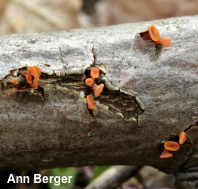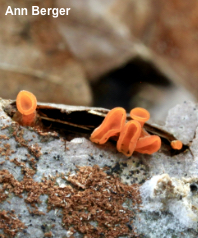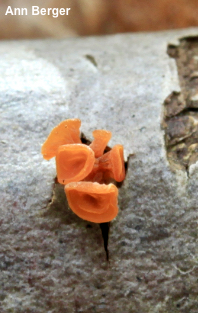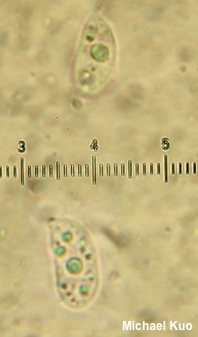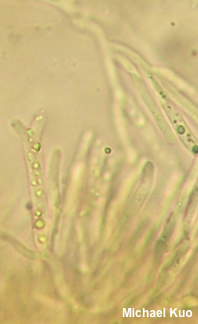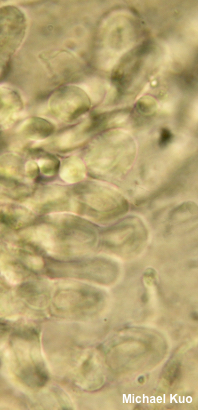| Major Groups > Jelly Fungi > Guepiniopsis buccina |

|
Guepiniopsis buccina [ Basidiomycota > Dacrymycetales > Dacrymycetaceae > Guepiniopsis ... ] by Michael Kuo This very tiny jelly fungus is found on the deadwood of hardwoods. Its North American distribution isn't exactly clear, but it is at least widespread east of the Great Plains. The tiny mushrooms can be tentatively recognized by their hardwood habitat, their size (8 mm across is a giant specimen), and their top-like shape, with a flattened or concave upper surface and a narrowing stem-like structure that often becomes wrinkled or even ridged with development. However, microscopic features should also be assessed before betting the house on your identification of Guepiniopsis buccina, Look for slightly bent ellipsoid spores, Y-shaped basidia, the absence of clamp connections, and the palisade of cortical hairs that covers the stem-like structure: the hairs are thick-walled, with cylindric to club-shaped apices. On the wood of conifers, Guepiniopsis alpina is very similar in macroscopic features, although it is usually somewhat larger. However, it is very different under the microscope, featuring conspicuous clamp connections and differently shaped cortical hairs. Thanks to Fluff Berger for documenting, collecting, and preserving Guepiniopsis buccina for study; her collection is deposited in The Herbarium of Michael Kuo. Description: Ecology: Saprobic on the deadwood of hardwoods; growing alone or gregariously from cracks in the bark or wood; usually appearing in spring; in North America widely distributed from the Great Plains eastward, and possibly appearing in western North America as well, at least in scattered locations; originally known from Europe; also recorded from South America, Asia, and Oceania. The illustrated and described collection is from Pennsylvania. Fruiting Body: Shaped more or less like a tiny top, with a clearly defined upper surface; 2–8 mm across and 2–5 mm high; usually with a clearly defined stem or pseudostem. Upper Surface: Orange, orangish yellow, or yellow; bald; flat or a little concave. Stem and Undersurface: Narrowing to the base; colored like the upper surface or slightly paler, rugged; developing vertical grooves or ridges. Flesh: Orangish to yellowish; gelatinous and softly rubbery. Odor: Not distinctive. Microscopic Features: Spores 12–15 x 5–6 µm; ellipsoid to slightly allantoid; usually slightly curved; smooth; long aseptate but eventually developing 3 septa; hyaline in KOH. Basidia Y-shaped; smooth; hyaline in KOH. Probasidia cylindric to clavate, developing Y prongs. Contextual hyphae 2–4 µm wide; smooth; hyaline in KOH; clamp connections not found. Cortical hairs arranged in a palisade; 25–35 x 5–10 µm; cylindric to clavate; walls 2–5 µm thick; hyaline in KOH; smooth. REFERENCES: (Persoon, 1801) LL Kennedy, 1959. (Brasfield, 1938; Martin, 1952; Lowy, 1971; Reid, 1974; Læssøe & Petersen, 2019.) Herb. Kuo 04222001. This site contains no information about the edibility or toxicity of mushrooms. |
© MushroomExpert.Com |
|
Cite this page as: Kuo, M. (2020, May). Guepiniopsis buccina. Retrieved from the MushroomExpert.Com Web site: http://www.mushroomexpert.com/guepiniopsis_buccina.html |
